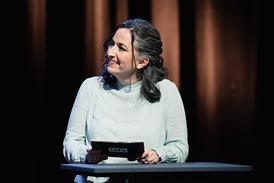The director of the first commercial thriller ever made in Laos talks about kickstarting a film industry in his country.
Anysay Keola is trying to develop a commercial film industry in his country of 6.5 million people, which only makes around six films a year, mostly with help from Thailand, and only has a handful of cinemas.
He is the founder of filmmaking collective Lao New Wave Cinema and the director of Laotian-language thriller At The Horizon. The film, about a young rich boy who wakes up after a night of partying to find he’s been captured by a stranger, opened to a full house last weekend in the capital of Laos, Vientiane.
Born in Vientiane, Keola studied at Monash University in Melbourne, Australia and is currently a student at Chulalongkorn University in Bangkok.
How did you get into filmmaking?
I’ve always been into manga – Japanese manga translated into Thai, which is quite close to Laotian. But I didn’t fall in love with filmmaking until I studied visual effects at Monash and made a few short films. After graduation, I worked for an NGO in Bangkok and joined every filmmaking workshop I could find. I quit my job in 2009 and started a Master of Arts in Film at Chulalongkorn University. At The Horizon is my thesis film.
How did you finance the film? Did you have support from the Lao government?
To shoot and screen a movie in Laos, you have to submit the script to the Cinema Department, and at first they banned the film because they thought it was too violent. But I didn’t give up and explained that this is my thesis project, and promised I would only show it to my university advisor, and finally they agreed.
The budget so far is around $15,000. At first we had a private investor in Laos, but my family was worried when they found out he had the DVD rights, because the film is banned and my mother works for the government. So my family bought the rights back.
Is the film still banned?
When we finished shooting and had a first cut, the Luang Prabang International Film Festival pushed the government to let them screen the film, as they argued it would be good for Laos to have a local film in the festival. I also showed the finished film to the Cinema Department, so they could see it has a positive message and doesn’t critcise the government, and they allowed me the screen the film on the condition that we make some adjustments when we released it locally.
What kind of film industry does Laos have at present?
Before the Communist liberation in 1975, we had the Golden Age of Lao cinema, when he had lots of theatres and could also see foreign films. Afterwards we only had propaganda films and the cinemas closed down. From around 2006, perhaps a bit earlier, a production house called Lao Art Media started making films for TV broadcast, but not screening in theatres. A few years later, they co-produced a film with Thailand [romantic drama Sabaidee Luang Prabang] and a new theatre opened at the Lao ITECC convention centre near Vientiane. The movie starred Ananda Everingham [Thai star with Lao heritage] who had enough magnetism to bring many Lao people back to the movie theatre.
How did you find cast and crew if there is no commercial film industry in Laos?
I had no connections before I made this film, so had to go back to Laos and begin to assemble a team. Most are freelance or own small production houses working in TV, music videos and advertising. For the cast, we announced a casting call through Facebook and some local newspapers. Most of the cast are stage actors so we held workshops to help them adapt. I used an SLR camera, which is affordable, and got people to give us lighting rental very cheap.
With do you hope to achieve with Lao New Wave Cinema?
My first goal is to change the face of Lao cinema – to improve and develop it and encourage Lao people to watch Lao movies – and to do that we have to convince them that Lao movies can be good. Our first step was to make a movie based on the belief and trust of the crew – everyone came to work on it knowing we couldn’t pay them. We hope this will convince the private sector that we can do it, our people can do it.
Do you think there is potential for Lao movies to travel further afield?
I’ve discussed this issue with my team and we hope that we can open the market in Thailand. We don’t expect the whole of Thailand, only the eastern part Isaan, which has a similar language and culture to Laos and about 40 million people.
What’s your next project?
I’m editing a new movie from my own team. It’s a comedy directed by Phanumat Disattha, who is also a graduate from a Thai university. He holds a Thai passport, but his parents are from Laos, and I can proudly say that he is still Lao. That’s not to say that I don’t want Thai involvement – my own movie has a Thai editor – but the main team on our films has to be Lao.































No comments yet